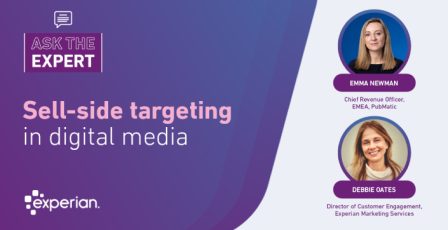Ask The Expert: Navigating market challenges with Sarah Robertson
Ask the Expert: A Q&A series about brands and publishers with product experts
Welcome to another edition of Ask The Expert. In this edition, we had the pleasure of speaking with Sarah Robertson, Director of Products at Experian Marketing Services. Sarah shared her insights on the challenges faced by brands and publishers and how Experian was stepping up to support them.
Understanding market challenges
The marketing industry was in a constant state of evolution. Sarah highlighted that despite Google’s decision not to fully deprecate third-party cookies, the industry had already innovated around this challenge. Brands, agencies, and publishers each had unique needs, and Experian was committed to understanding and addressing these through continuous dialogue and innovation.
Experian’s approach to identity and privacy
A significant focus for Experian over the past 12 to 18 months had been on identity. Sarah explained how Experian was helping clients translate identity from the offline world to the online world, a journey initiated by changes in Google’s policies. Identity was crucial as it underpinned measurement, audience targeting, and many other solutions within the industry.
Privacy was another cornerstone of Experian’s approach. Sarah emphasised the importance of consumer-centric privacy practices, ensuring that all innovations were built with privacy by design. This meant involving privacy considerations from the very beginning of product development, not as an afterthought.
The role of first party data
The shift towards first-party data collection was driven by advancements in cloud computing, AI, and machine learning. These technologies enabled publishers to make sense of unstructured data and create meaningful insights. Clean rooms had also facilitated more privacy-centric data sharing, enhancing the use of first-party data at scale.
Supporting brands and publishers
Experian supported brands by helping them understand their customers beyond basic transactions. For example, a holiday company could use Experian’s data to gain deeper insights into their customers’ purchasing behaviours and preferences, enabling more effective marketing strategies.
For publishers, Experian provided tools to better understand their audience. By combining contextual and audience data, publishers could offer more valuable advertising opportunities. This approach helped advertisers reach the right audience with the right message at the right time.
Introducing Consumer Sync
Consumer Sync was a ground-breaking solution that linked offline and online identities, allowing brands and publishers to better understand and engage with their audiences. Sarah shared a practical example of how Consumer Sync could help a brand identify and personalise interactions with unknown users on their website, enhancing the overall customer experience.
The future of Experian Marketing Services
Looking ahead, Experian was expanding its solutions across Europe, with plans to introduce Consumer Sync in key markets such as the Netherlands, France, Germany, Spain, and Italy. Additionally, Experian was developing real-time personalisation and measurement solutions to further support brands and publishers in delivering exceptional customer experiences.
Final Thoughts
Sarah concluded with advice for brands and publishers: prioritise scale, flexibility, interoperability, and innovation when choosing solutions. Ensuring that these solutions were privacy-centric and GDPR compliant was crucial for long-term success.
Thank you for joining us for this insightful discussion with Sarah Robertson. Stay tuned for more expert insights in our next edition of Ask The Expert.
Speak to the team
Find out how Consumer Sync will understand, activate and measure for your business.
Let's talk
Welcome to Ask The Expert.
So today we have Sarah Robertson, our Director of Products at Experian, here to talk about some of the challenges that we see out in the market from some of our brands and publishers specifically and what Experian are doing to support that.
So welcome, Sarah.
Thank you.
Good to have you here.
As a bit of an intro, would you be able to give an intro to yourself, who you are and what you do Experian? So yes, I’m Sarah Robertson.
I am Director of Products at Experian Marketing Services here in the UK.
That means that my responsibilities are looking after our product and innovation, so speaking to our clients, partners, agencies, brands, all of those types of clients, to really understand their needs within the marketing space.
And in terms of then these solutions and as I alluded to before, we’re here to discuss about some of the market challenges.
What are you hearing right now in terms of challenges that our clients are facing? So the marketing industry has always been innovative and it’s always been evolving.
We heard recently around Google and how it was no longer fully deprecating the third-party cookies.
But the industry had already innovated around that solution and how they could facilitate those changes.
We’ve got many different clients in marketing services.
We have brands and agencies, we have publishers, we had ad tech partners as well.
So we service across the whole ecosystem.
Each of them have slightly different needs, so we’re constantly listening to their needs.
Publishers want to really understand the consumers that are hitting their sites to monetise their content more effectively.
Brands have always really looked at a single thing, so how can they make the most performant marketing campaigns.
So that continues to be their key need.
And the agencies really want efficient solutions so that they can service all of their brands and come to market with new ideas constantly.
And that’s what the agencies are looking to us for.
Great.
What’s Experian’s position to support the market with these challenges? So really what we’ve been focusing on in the last sort of 12 to 18 months is identity and how we can help brands, agencies, AdTech and publishers really translate identity from an offline world into an online world.
We started on that journey because of the Google decision.
We still think that’s a great journey really.
And identity underpins measurement, it underpins audiences.
It underpins a lot of the solutions that we need within the industry.
So that’s why we’ve been focused on.
We’ve also been focused on looking at more dynamic data.
We’ve always had a really good backbone on our demographic data, our segmentations are world renowned.
But really, how do we make those more dynamic and more relevant in the moment? So that’s great.
It’d be great to expand on some of these points and I think privacy underpins a lot of the digital marketing ecosystem today.
I just want to get your view on what privacy really means and why is it of ever-growing importance in digital marketing? Privacy is key, right? So when I think about privacy, I think about the consumer.
Really put yourself in their viewpoint.
Can you explain it? Would they expect it as an industry? So really think about that.
If people don’t expect to be tracked from one site to another, if people don’t want to be listened toon their Alexa at home, is that really privacy centric? I always think about, can you explain it to your gran? Can you explain it to your mum? Do they really understand what we are doing as an industry, and can we really be proud of what we’re doing? And those are the key things that I always think about in a privacy centric world.
When we think about privacy by design, what does privacy by design mean and what does it mean to Experian more to the point? So when we’re coming up with a new product, when we’re thinking about the need of the client and what we’re trying to solve for, we then have to think about the data that’s required in that.
And when we came up with the Consumer Sync proposition, I’d never spent so much time with privacy lawyers because there was lots of ways to build the solution.
So actually, thinking about the solution and thinking about it not only in today’s privacy centric world, but what are the potential changes that happen in the future is really key.
So before we even launch a product, the privacy concept has been put into the very essence of how we build that particular viewpoint.
It’s not just a checkbox exercise for us where we go to compliance after we’ve designed a product.
It must be throughout every part of our innovation.
We’re always looking for more privacy centric ways to drive performance marketing campaigns.
Whether that’s influence of clean rooms, whether that’s obfuscation of data, whether that’s synthetic data.
All of these things can really improve the privacy of our consumers.
So we’re looking at that throughout all of our innovations right now.
Okay.
And how would you summarise how exactly Experian stand out in this respect? We continually review the regulatory frameworks.
We support with lobbying government for better privacy laws within the UK.
We also were heavily involved with the ICO and we recently stood behind our view of privacy.
We know that we need to take a really clear and heavy stance.
We’re a consumer led organisation.
We’ve got a consumer brand which also helps our privacy and transparency frameworks.
So, moving on from privacy to talk about data more specifically, there’s been a big drive recently to collect more first party data.
What’s your view on why that is? I started my career utilising first party data, working with different brands and different organisations, looking at their behaviour and transactional data.
The real shift over recent years is more and more publishers utilising their first party data.
That’s come from the onset of partly cloud computing, partly the onset of artificial intelligence and machine learning algorithms, being able to really take that unstructured data and create meaning of the contextual signals that are available to them.
Clean rooms have also supported this because actually people are more likely to share their first party data in a more privacy centric way.
So, whilst first party data has always been around, or has been for several years, there is a shift to how it’s been used at scale across the advertising ecosystem.
Okay.
And if we think there about, a few things you said there, collaboration and scale, if we think about first party data and third-party data, what do you see as the relationship between those two? When I think about data, I think about creating campaigns and creating marketing activity and it’s really important across marketing activity to understand Who.
So who is going to respond to your activity? The What.
So, what did they do and what do you want them to do? The Why.
Understanding their attitudes that’s creating them to purchase or their life stage.
And then the Where.
So where are they going to purchase? You can’t get all of that information purely from first party data.
So that’s when that interjection of the second party and third-party data really come into its own to understanding that full view of a customer, so that you can really drive home that marketing activity and also that you can understand which audiences have responded.
So how do you manage the outcomes of that? Excellent.
So, talk me through then how we would support brands in this respect.
Yeah, so if you just take a holiday company, for example.
So as a particular holiday company, I may see a purchase from a consumer and I might see two identical consumer purchases, both for a £4,000 holiday.
I can’t take those and really understand that consumer differently.
What’s the share of wallets? Where else are they purchasing? Why did they purchase that holiday? To really get to that understanding of how can I get them to purchase again? How can I upsell them? How can I cross sell them within that initial journey? So, utilising all of that data across the campaigns that you’re trying to drive.
So, it’s really delving into detail.
Okay.
So that’s, I guess, on one side of the coin, we’ve talked about brands, and then on the other, let’s talk about publishers.
So, I guess, firstly, can you define what we mean by a publisher? In my view, the definition of a publisher is really broad.
Anybody who has got any space, whether that be on an app, whether that be on a TV screen, for example, Samsung have a home screen that they can inject advertisements into as are other TV manufacturers.
As is a website, for the example of Boots.
They have space on their site for advertising.
All of these can be classed as a publisher.
Okay, great.
So that’s a good definition of what a publisher is.
Can you describe to me exactly how we support publishers? The utilisation of audience data.
Publishers are really rich and contextual.
They understand the detail around what people are viewing on their site, when are they viewing it, but they really don’t understand who is viewing it.
Two people that look at FA Cup Final information, they might look vastly different.
They might have different examples of share of wallet.
They might be at different life stages.
So actually, just a contextual advertising isn’t really going to give advertisers the true value, which is why there’s the big trend toward more curated audiences where we’re using that interjection of audience and contextual data.
Okay, fantastic.
So great insight into how that helps both brands and publishers.
We recently launched Consumer Sync.
Can we give an overview of what exactly Consumer Sync is first? Yeah, so Consumer Sync allows agencies, brands and publishers to really link the offline world to the online world.
So taking a household and understanding their online presence across multiple identifiers.
That’s in its simplest form.
Why that’s really key is so that you can interject that audience data, so you can understand who, so you can onboard your first party data onto all of those channels.
And I think it’s always good to talk about a story, so do you have any stories that we could talk through in terms of the application of this and what that would look like from start to finish? There’s many applications for it.
Say we have a brand.
A brand would have someone that lands on their site.
So, when someone lands on their site, many of those users, they don’t know who they are.
So utilising Consumer Sync, we can link that unknown user to a known household.
Utilising that household identity, we can then say who are they? How old are they? What life stage are they in? What’s their affluence? All of that information, all of that audience data, so that the next time they land on site, we can make more personalization recommendations.
We can understand how to change the site for that individual.
For publishers, it can help them really utilise the audience data to make more of their contextual data.
So how can they monetise their inventory more effectively, because they understand that in detail for their advertisers? So they understand that someone who hits the news at three o’clock in the afternoon is a certain demographic and they know what they’re looking at.
They know their page that they’re looking at, so they can make sure that the context is relevant for the audience, for the advertiser in campaign that happens at that point in time.
Great.
So that’s great.
It’s really insightful in terms of how it helps both brands and publishers.
We talked thereabout the identity side of the coin, but then when you talk about the insight and audience side of the coin, Experian has been well known for rich datasets for many years.
Can you talk me through what that looks like today and the types of audience data that people can have access to? So, we’ve got all of the traditional demographic audiences that we’ve had for several years and that we’re well known for.
Those continue to best in class in terms of how they’re built, the reliability, our transparency around all of those audiences.
We realised that actually those are quite static and someone’s age only changes once a year.
But what about other data? So, we’ve recently invested to get more data, so we’re looking at spending sites.
So, understanding how people are spending their money.
We’ve got a really large panel of users.
We’ve got a really good relationship with many of the research companies.
So we’ve got linkage into research data, again to understand the why.
So attitudinal data.
And we’ve also got data around mobility.
So, foot fall, which is based on actual people movement, so we can understand how people are shopping and where they are at certain points of the day.
And all that is underpinned by our demographic data.
So it’s not just understanding the spend distribution.
It’s understanding who is spending that money.
It’s not just understanding how many people are in a location, it’s understanding exactly who’s in that location, and how are they shopping? Which is a very unique value proposition to have those two things combined.
Yes.
On that note, so in terms of the audience insight you just described there is very rich.
Can you talk me through the scale that’s behind it? In terms of our audience insight, we do have everybody in the UK pretty much.
So, we’ve got 95% population coverage.
Consumer Sync is a household level product and we cover 82% of UK households.
Great.
Could you summarise, Sarah, exactly how you see Experian standing out in the market when it comes to privacy? Yeah, so with Consumer Sync, we deliberately went with a household level solution and went with a household solution for three primary reasons.
One of those was privacy.
We felt a household level solution was more privacy centric.
The other reason around that was purchasing decisions.
So many people purchase at household.
How many times do you ask your wife, what do you want for tea? It’s like a constant question within a household.
You discuss holidays, you discuss cars, you even discuss clothes.
All of these are household level purchase decisions.
The other one is devices.
There are very few devices that aren’t shared within a household.
So, think about how many times you give your child your iPad to watch or your iPhone and your TVs and your laptop, apart from your work laptop is all joint devices in a household.
So, in fact, you very rarely know exactly who is looking at something, but you know that the household is viewing that.
So that’s the primary reason why went for a household level solution.
Okay, great.
That’s privacy when we look at Consumer Sync, but can you talk us through exactly how we build privacy into our audience data products? Yeah, our audience data is really primarily through our ConsumerView product.
So, ConsumerView is based on our legitimate interest processing.
It’s where we had our recent appeal against the ICO.
So we build that in a number of ways.
We have several machine learning and AI models that build that.
They utilise seed data to scale across the UK population.
Okay, great.
That’s how we build privacy into audience data but when we think about transparency, can you talk me through how we are transparent and how we manage and process data? Because we build under legitimate interest, transparency is key to that.
So, we developed the consumer information portal, which is a website that explains to consumers exactly how we use our data.
It’s really accessible.
It talks about our key partners.
You can opt out utilising that.
You can have a data subject access request through that site.
We also, because we have a public facing brand experience that also drives usage to our consumer information portal.
So it aids our transparency as a public facing brand.
Okay.
Great.
It’s been great to talk through a lot of the stuff that we’re up to today and that we bring into the market and how we address certain very important factors such as privacy, transparency.
Retail media is a relatively hot topic right now.
Can you talk me through exactly how Experian marketing services could support, let’s say, a retail media network as a first instance? Before we go on to that, we’ll explain why retail media has become the top topic of the point.
So many brands, if we talk about an FMCG brand who are selling baked beans, they have very little first party data.
It’s really difficult to understand who’s actually purchasing their products.
So, retail media has always been around, right? Store promotion has always been a thing.
What really now happens is, how does that store promotion come out of the store and onto the retailer’s website and then utilising the retailer’s data off site as well? So how is that retailer’s data used in the open web targeting and also through into walled gardens.
That’s really key when we’re talking about retail media.
Yep.
Great.
So how we support those, well, we have a linkage solution in Consumer Sync.
So what that allows us to do is it allows us to support retailers really utilise their data.
So on site within their own environment, so again, we can utilise that unauthenticated, unknown users on their site where they’re looking at that can of baked beans.
We can understand who they are and we can press that across and we can extend that across different channels.
We can take their offline data and we can make that usable across digital channels as well.
We can understand the demographics, so we can make the advertising more relevant to the audience as well.
Utilising all of our data, we can really lean into the retail media.
Okay, excellent.
We talked there a lot about the current challenges, but can you talk us through what is on the roadmap for Experian in the near future? So, since we’ve launched Consumer Sync, we’ve really seen a demand across other key markets in Europe.
We’ve got a solution coming which will allow us to do a similar solution to Consumer Sync, but in five core markets.
So within the Netherlands, France, Germany, Spain and Italy, which will allow us to inject audience data and do some identity resolution in those markets.
Okay.
The other area that we’re looking into is personalisation.
We talked a lot about unknown users, so actually, how can you personalise a website in the moment and those customer experiences and really maximizing the customer experiences people have on your site or in your app? We’ve got a real time personalisation solution where we can inject audience data into those solutions, and that’s coming soon.
We’re also looking at later on is measurement.
So how can we really lean into measurement utilising again, our offline and online Consumer Sync solution to really bring an end-to-end measurement solution together? So great.
Thanks.
We’ve covered a lot off therein terms what the market looks like for both brands and publishers and the challenges there they’re facing and how Experian are supporting them.
It would be great just to close out and get your advice to them on what they should look for when weighing up these solutions.
So, scale is key.
So does it cover everything that you need it to do? What proportion of your market does the solution give? Flexibility and interoperability.
So flexibility in terms of the audiences, does it give you the scale of the audiences? Have you got interoperable identity underpinned by privacy? Have they got the right attitude to privacy in terms of the solution? Are they GDPR compliant? All of those things should come into it.
And then innovation.
So really, are you partnering with an organisation that’s really got innovation at its core and will continue to evolve their solutions? Okay, great.
Well, I think we can wrap up there.
That’s been a really insightful discussion.
Always great to get your view, Sarah, on exactly what you’re hearing in the market from our brand and publisher partners.
We appreciate your time.
Thank you.
And thank you very much for listening in and do watch out for the next Ask The Expert.









